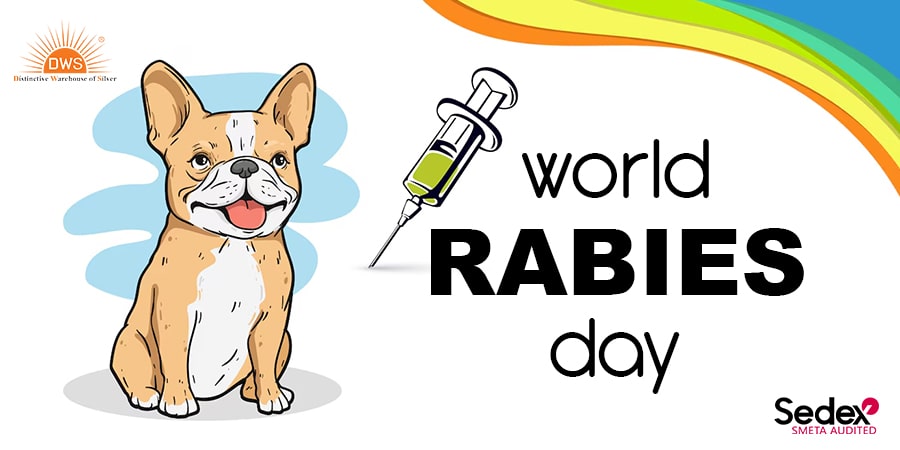- Written By Team DWS
- Festivals
- August 22, 2025
World Rabies Day: Uniting for a Rabies-Free Future
Rabies is one of the world’s oldest and most terrifying zoonotic diseases, notorious for its nearly 100% fatality rate once symptoms appear. Yet, this dreaded disease is fully preventable through accessible animal vaccines, public awareness, and timely post-exposure care. Every year, on September 28th, World Rabies Day unites health professionals, governments, educators, and communities in a powerful day of action and advocacy. But beyond a single day, it’s a reminder of the persistent challenge of rabies and the urgent call for global elimination by 2030.

1. Why We Observe World Rabies Day
World Rabies Day is observed annually on September 28th. This date was chosen as it marks the death anniversary of Louis Pasteur, the pioneering French chemist and microbiologist who developed the first rabies vaccine. Today’s observance is much more than symbolic—it’s an all-out effort to amplify crucial rabies prevention messages, encourage the vaccination of pets, and support at-risk communities in their fight against a disease that is still all too present.
2. The Origin of World Rabies Day
World Rabies Day was first launched in 2007 by the Global Alliance for Rabies Control (GARC), in partnership with the World Health Organization (WHO), the Pan American Health Organization (PAHO), the World Organisation for Animal Health (WOAH), and the US Centers for Disease Control and Prevention (CDC). Since then, it has grown into a truly global event with thousands of educational activities, free vaccination drives, and policy announcements across every continent. By the end of its first decade, it was estimated that the campaign had directly reached nearly 100 million people and vaccinated millions of dogs around the world.
World Rabies Day is now recognized as an official United Nations Observance. Its reach continues to expand each year, especially in communities where rabies is still an ever-present risk.
3. Understanding Rabies: A Persistent Global Threat
a. What is Rabies?
Rabies is a deadly viral disease caused by a virus in the Lyssavirus genus. It primarily spreads through the bite or scratch of an infected animal—most commonly domestic dogs. Once clinical symptoms begin, rabies is virtually always fatal.
b. The Burden in Numbers
- Global Deaths: Each year, rabies claims the lives of over 59,000 people worldwide.
- Children at Risk: Around 40% of victims are children under the age of 15, who are more likely to interact with animals.
- Geographical Hotspots: Over 95% of human deaths occur in Africa and Asia, where dog-mediated rabies remains endemic and access to timely care is limited.
- India’s Toll: India alone accounts for about 36% of global rabies deaths, illustrating uneven patterns of disease distribution and persistent gaps in prevention.
c. Why is Rabies Still Uncontrolled?
Rabies remains a “neglected tropical disease” — ignored partly due to lack of awareness, resource constraints, and competing public health priorities. Animal reservoirs, especially unvaccinated dogs, sustain transmission cycles. In many regions, knowledge about prevention and the need for immediate post-exposure prophylaxis is still insufficient.
4. The Science and History Behind Prevention
Louis Pasteur and the First Rabies Vaccine
The world’s first rabies vaccine was developed by Louis Pasteur and Émile Roux in the 1880s. Pasteur’s revolutionary experiments offered the first real hope against this ancient scourge. The anniversary of Pasteur’s death is thus fitting for World Rabies Day, signifying both scientific achievement and the continued journey toward global elimination.
Progress in Animal and Human Vaccines
Modern vaccines for both humans and animals are safe, effective, and widely available. Vaccination of dogs is the single most cost-effective strategy for preventing human rabies deaths, because dogs are responsible for up to 99% of human cases.
5. The “One Health” Approach and Breaking Boundaries
The 2024 Theme: Breaking Rabies Boundaries
For 2024, the theme of World Rabies Day is “Breaking Rabies Boundaries”. This theme highlights the urgent need to move beyond the status quo and adopt cross-sectoral, cross-border collaboration. Rabies is a disease without borders—it infects humans, domestic pets, livestock, and wildlife alike. Only a unified, "One Health" approach—integrating human, animal, and environmental health sectors—can ultimately defeat the disease.
This integrated collaboration is not for an exclusive few, but must be extended to reach the poorest and most rural communities who typically bear the brunt of rabies deaths.
6. How World Rabies Day Is Commemorated
World Rabies Day is marked by a wide variety of activities, big and small, around the globe:
- Vaccination Drives: Free or subsidized vaccinations for dogs and sometimes cats, in at-risk regions.
- School Campaigns: Educational workshops in schools, reaching children—the most vulnerable group.
- Awareness Marches and Rallies: Community events to circulate information about animal bite prevention, first aid, and the importance of vaccination.
- Veterinary Outreach: Training for veterinarians and animal handlers.
- Social Media Campaigns: Sharing facts, infographics, and stories to amplify the message worldwide.
- Policy and Announcement Days: Governments and international agencies use World Rabies Day to launch programs, review progress, and reaffirm elimination targets.
7. Practical Prevention: What Everyone Should Know
a. Preventing Dog-Mediated Rabies
- Vaccinate All Dogs: Dog vaccination is the cornerstone of rabies prevention.
- Control Free-Roaming Populations: Humane population management reduces the risk of exposure.
- Responsible Pet Ownership: Train, vaccinate, and care for pets, and educate communities about not approaching unknown or aggressive animals.
b. What To Do If Bitten
- Immediate Wound Washing: Wash the wound thoroughly with soap and water for at least 15 minutes—the single most effective lifesaving first aid.
- Seek Medical Attention: Get to a health facility as quickly as possible.
- Post-Exposure Prophylaxis (PEP): Rabies vaccines and immunoglobulin, administered promptly, are almost 100% effective in preventing disease onset.
- Report the Incident: Alert local health and veterinary authorities to monitor the biting animal and prevent further cases.
c. Special Considerations for Children
Children must be taught:
- Not to approach unfamiliar animals.
- To report every scratch or bite immediately.
- The importance of telling adults what happened, even if the wound looks mild.
8. The Global Elimination Target: Zero by 2030
A united global goal—often referred to as “Zero by 30”—aims to eliminate dog-mediated human rabies deaths by 2030. This is achievable through:
- Sustained mass dog vaccination programs.
- Public education.
- Access to affordable human vaccines and immunoglobulins.
- Political commitment and sufficient funding.
- Reliable surveillance data to target interventions.
International organizations like WHO, PAHO, WOAH, GARC, and FAO spearhead these efforts in partnership with governments and NGOs.
9. Key Achievements and Progress
- Americas’ Success: Latin America and the Caribbean have seen remarkable reductions in human rabies cases through coordinated dog vaccination, surveillance, and public education since the 1980s.
- Improved Access: Increasing numbers of countries have incorporated canine vaccination and rabies education into their public health strategies.
- Advocacy Milestones: World Rabies Day has become a platform for governments to announce new elimination strategies and share data on progress, keeping global efforts on track.
10. Persistent Challenges and Solutions
Despite progress, several obstacles remain:
- Vaccine Accessibility: Ensuring all at-risk populations, especially in remote and underserved regions, receive both animal and human vaccines.
- Stray Dog Population Management: Balancing humane animal welfare with public health needs.
- Fragmented Surveillance: Weak data systems make it difficult to monitor, respond to, and prevent outbreaks with precision.
- Cultural Myths and Stigma: In some areas, suspicion of vaccination campaigns or misinformation about animal control statuses hinders progress.
- Limited Funding: Rabies, as a “neglected” disease, often falls behind more prominent health priorities.
Solutions: Strengthening community engagement, increasing public-private partnerships, building robust surveillance systems, and prioritizing rabies elimination in national health policies are key.
11. Frequently Asked Questions (FAQs)
1. Can rabies be cured once symptoms appear?
No, rabies is almost always fatal after clinical symptoms begin. Treatment must start immediately after exposure.
2. Which animals carry rabies?
Dogs are the primary reservoir globally. Wild animals (bats, raccoons, foxes) also play a role, especially in the Americas, Europe, and Australia.
3. Can indoor pets get rabies?
Yes, if bitten or scratched by infected animals. Annual vaccination is important for all pets.
4. How often should pets be vaccinated?
Follow local veterinary advice—usually annually or every three years, depending on laws and vaccine brands.
5. Is rabies eradication possible?
Yes—for dog-mediated human rabies. With coordinated vaccination and awareness, countries such as Japan, parts of Western Europe, and the Americas have substantially reduced or eliminated human cases.
12. Stories of Hope: Rabies Elimination in Action
- The Philippines: National awareness campaigns and routine dog vaccination programs have rapidly reduced human rabies cases and fostered community responsibility.
- Tanzania: Comprehensive “One Health” projects bring together animal health, human health, and education sectors for remarkable local elimination results.
- Latin America: Mass dog vaccination and public education campaigns have led to dramatic declines in both animal and human rabies cases.
These successes reinforce that rabies prevention works and saves lives when communities, governments, and global organizations unite.
13. The Role of Technology and Social Media
In today’s connected world, social media, mobile apps, and online platforms are powerful tools for rabies education, awareness, reporting animal bites, and registering local World Rabies Day initiatives. The Global Alliance for Rabies Control’s online event registration and educational material repository helps break down geographical boundaries, making it easier for even small communities to join the global movement.
14. How to Get Involved: Action Steps for Individuals and Organizations
- Share Information: Talk about rabies prevention on social media or in your community.
- Participate in Events: Join local vaccination drives, school programs, or World Rabies Day rallies.
- Promote Pet Vaccination: Encourage family and friends to keep their pets’ vaccinations current.
- Volunteer: Offer your time or expertise to local animal shelters, health clinics, or rabies control projects.
Every act counts—whether you’re a pet owner, parent, teacher, health professional, policymaker, or simply a concerned citizen.

15. Looking Ahead: A Call to Action
Rabies is an ancient adversary—resistant, persistent, and deadly. Yet, we now have the medical tools, knowledge, and collaborative spirit to end its toll on humanity. By “breaking boundaries”—geographical, professional, and societal—we can push toward a world where zero human deaths from dog-mediated rabies is the norm, not the exception.
World Rabies Day is not just a date on the calendar. It is an opportunity and a responsibility. It invites each one of us to join the fight for a rabies-free future—for every community, every child, and every animal.
Popular on Blogs

Black Tourmaline: Meaning, Healing Properties, Fascinating Facts, Powerful Attributes, Versatile Uses, and Beyond
September 05, 2023 / BY Team DWS
Black Tourmaline, also known as Schorl, is a highly revered crystal with incredible metaphysical properties. It derives its name from the Dutch word "turamali," meaning "stone with ..

Carnelian Stone: Meaning, Healing Properties, Power, Facts, Color, Uses and More
December 26, 2023 / BY Team DWS
Carnelian is a vibrant and captivating gemstone that holds a plethora of meanings, healing properties, and powers. Its warm and fiery energy makes it a popular choice among crystal ..

Citrine: Exploring its Meaning, Healing Properties, Fascinating Facts, Powers, Versatile Uses, and Much More
November 18, 2023 / BY Team DWS
Citrine, with its warm golden hues, has captured the attention and imagination of people for centuries. This beautiful gemstone, commonly associated with wealth and prosperity, hol ..

Black Onyx: Unveiling the Meaning, Healing Properties, Fascinating Facts, Powerful Attributes, Versatile Uses, and Beyond
July 25, 2023 / BY Team DWS
Black Onyx, a striking gemstone admired for its deep black hue and elegant appearance, has captivated people for centuries. In this comprehensive guide, we will delve into the mean ..

Unveiling the Mysteries of Turquoise Stone: Exploring its Meaning, Healing Properties, Power, Facts, Color, Uses, and More
December 05, 2023 / BY Team DWS
Turquoise, with its captivating blue-green hue, has been adorning jewelry and artifacts for centuries. This striking stone has a rich history, rich symbolism, and a plethora of int ..

The History Behind The Popularity of Red Agate
December 23, 2022 / BY Team DWS
An Agate is a type of magma rock that takes many years till it is washed out naturally into the water. And that is the reason this stone has elements of water. This beautiful stone ..

Bloodstone: Unveiling the Meaning, Healing Properties, Facts, Powers, Uses, and More
August 21, 2023 / BY Team DWS
Bloodstone, with its captivating deep green color with specks of red, is a mesmerizing gemstone that has fascinated civilizations for centuries. It possesses unique healing propert ..

Plan a Perfect Valentine's Week with Our Valentine Week List 2025
January 22, 2024 / BY Team DWS
Valentine's Day is undoubtedly the most romantic day of the year, but we believe that one day is just not enough to express your love and make your partner feel special. That's why ..


